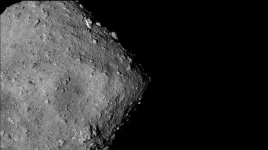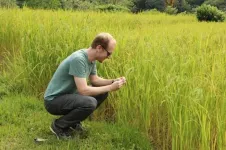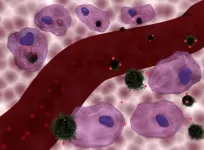(Press-News.org) PROVIDENCE, R.I. [Brown University] -- Last month, Japan's Hayabusa2 mission brought home a cache of rocks collected from a near-Earth asteroid called Ryugu. While analysis of those returned samples is just getting underway, researchers are using data from the spacecraft's other instruments to reveal new details about the asteroid's past.
In a study published in Nature Astronomy, researchers offer an explanation for why Ryugu isn't quite as rich in water-bearing minerals as some other asteroids. The study suggests that the ancient parent body from which Ryugu was formed had likely dried out in some kind of heating event before Ryugu came into being, which left Ryugu itself drier than expected.
"One of the things we're trying to understand is the distribution of water in the early solar system, and how that water may have been delivered to Earth," said Ralph Milliken, a planetary scientist at Brown University and study co-author. "Water-bearing asteroids are thought to have played a role in that, so by studying Ryugu up close and returning samples from it, we can better understand the abundance and history of water-bearing minerals on these kinds of asteroids."
One of the reasons Ryugu was chosen as a destination, Milliken says, is that it belongs to a class of asteroids that are dark in color and suspected to have water-bearing minerals and organic compounds. These types of asteroids are believed to be possible parent bodies for dark, water- and carbon-bearing meteorites found on Earth known as carbonaceous chondrites. Those meteorites have been studied in great detail in laboratories around the world for many decades, but it is not possible to determine with certainty which asteroid a given carbonaceous chondrite meteorite may come from.
The Hayabusa2 mission represents the first time a sample from one of these intriguing asteroids has been directly collected and returned to Earth. But observations of Ryugu made by Hayabusa2 as it flew alongside the asteroid suggest it may not to be as water-rich as scientists originally expected. There are several competing ideas for how and when Ryugu may have lost some of its water.
Ryugu is a rubble pile -- a loose conglomeration of rock held together by gravity. Scientists think these asteroids likely form from debris left over when larger and more solid asteroids are broken apart by a large impact event. So it's possible the water signature seen on Ryugu today is all that remains of a previously more water-rich parent asteroid that dried out due a heating event of some kind. But it could also be that Ryugu dried out after a catastrophic disruption and re-formation as a rubble pile. It's also possible that Ryugu had a few close spins past the sun in its past, which could have heated it up and dried out its surface.
The Hayabusa2 spacecraft had equipment aboard that could help scientists to determine which scenario was more likely. During its rendezvous with Ryugu in 2019, Hayabusa2 fired a small projectile into the asteroid's surface. The impact created a small crater and exposed rock buried in the subsurface. Using a near-infrared spectrometer, which is capable of detecting water-bearing minerals, the researchers could then compare the water content of surface rock with that of the subsurface.
The data showed the subsurface water signature to be quite similar to that of the outermost surface. That finding is consistent with the idea that Ryugu's parent body had dried out, rather than the scenario in which Ryugu's surface was dried out by the sun.
"You'd expect high-temperature heating from the sun to happen mostly at the surface and not penetrate too far into the subsurface," Milliken said. "But what we see is that the surface and subsurface are pretty similar and both are relatively poor in water, which brings us back to the idea that it was Ryugu's parent body that had been altered."
More work needs to be done, however, to confirm the finding, the researchers say. For example, the size of the particles excavated from the subsurface could influence the interpretation of the spectrometer measurements.
"The excavated material may have had a smaller grain size than what's on the surface," said Takahiro Hiroi, a senior research associate at Brown and study co-author. "That grain size effect could make it appear darker and redder than its coarser counterpart on the surface. It's hard to rule out that grain-size effect with remote sensing."
Luckily, the mission isn't limited to studying samples remotely. Since Hayabusa2 successfully returned samples to Earth in December, scientists are about to get a much closer look at Ryugu. Some of those samples may soon be coming to the NASA Reflectance Experiment Laboratory (RELAB) at Brown, which is operated by Hiroi and Milliken.
Milliken and Hiroi say they're looking forward to seeing if the laboratory analyses corroborate the team's remote sensing results.
"It's the double-edged sword of sample return," Milliken said. "All of those hypotheses we make using remote sensing data will be tested in the lab. It's super-exciting, but perhaps also a little nerve-wracking. One thing is for certain, we're sure to learn a lot more about the links between meteorites and their parent asteroids."
INFORMATION:
Repeated intravenous (IV) ketamine infusions significantly reduce symptom severity in individuals with chronic post-traumatic stress disorder (PTSD) and the improvement is rapid and maintained for several weeks afterwards, according to a study conducted by researchers from the Icahn School of Medicine at Mount Sinai. The study, published September XX in the American Journal of Psychiatry, is the first randomized, controlled trial of repeated ketamine administration for chronic PTSD and suggests this may be a promising treatment for PTSD patients.
"Our findings provide insight into the treatment efficacy of repeated ketamine ...
As the world grows increasingly globalized, one of the ways that countries have come to rely on one another is through a more intricate and interconnected food supply chain. Food produced in one country is often consumed in another country -- with technological advances allowing food to be shipped between countries that are increasingly distant from one another.
This interconnectedness has its benefits. For instance, if the United States imports food from multiple countries and one of those countries abruptly stops exporting food to the United States, there are still other countries that can be relied on ...
SAN ANTONIO and CHICAGO - An article published Jan. 5 in Alzheimer's & Dementia: The Journal of the Alzheimer's Association cites decades of published scientific evidence to make a compelling case for SARS-CoV-2's expected long-term effects on the brain and nervous system.
Dementia researchers from The University of Texas Health Science Center at San Antonio (UT Health San Antonio) are the first and senior authors of the report and are joined by coauthors from the Alzheimer's Association and Nottingham and Leicester universities in England.
"Since the flu pandemic of 1917 and 1918, many of the flulike diseases have been associated with brain disorders," said lead author ...
DURHAM, N.C. -- Self-control, the ability to contain one's own thoughts, feelings and behaviors, and to work toward goals with a plan, is one of the personality traits that makes a child ready for school. And, it turns out, ready for life as well.
In a large study that has tracked a thousand people from birth through age 45 in New Zealand, researchers have determined that people who had higher levels of self-control as children were aging more slowly than their peers at age 45. Their bodies and brains were healthier and biologically younger.
In interviews, the higher self-control group also showed they may be better equipped to handle the health, financial and social challenges of later life as well. The researchers used structured interviews and credit checks ...
NEW YORK, NY (1/5/2021) - Subtle changes in speech and language can be an early warning sign of Alzheimer's -- sometimes appearing long before other more serious symptoms. The challenge is recognizing these changes and determining what may signal Alzheimer's or other neurodegenerative disorders. In a commentary in END ...
One sweaty, huffing, exercising person emits as many chemicals from their body as up to five sedentary people, according to a new University of Colorado Boulder study. And notably, those human emissions, including amino acids from sweat or acetone from breath, chemically combine with bleach cleaners to form new airborne chemicals with unknown impacts to indoor air quality.
"Humans are a large source of indoor emissions," said Zachary Finewax, CIRES research scientist and lead author of the new study out in the current edition of Indoor Air. "And chemicals in indoor air, whether from our bodies or cleaning products, don't just disappear, they linger and travel around spaces like gyms, reacting with other chemicals."
In 2018, the CU Boulder ...
Heating up cancer cells while targeting them with chemotherapy is a highly effective way of killing them, according to a new study led by UCL researchers.
The study, published in the Journal of Materials Chemistry B, found that "loading" a chemotherapy drug on to tiny magnetic particles that can heat up the cancer cells at the same time as delivering the drug to them was up to 34% more effective at destroying the cancer cells than the chemotherapy drug without added heat.
The magnetic iron oxide nanoparticles that carry the chemotherapy drug shed heat when exposed to an alternating magnetic field. This means that, once the nanoparticles have accumulated in the tumour area, an alternating magnetic field can be applied from outside the ...
Researchers in Japan have made the first observations of biological magnetoreception - live, unaltered cells responding to a magnetic field in real time. This discovery is a crucial step in understanding how animals from birds to butterflies navigate using Earth's magnetic field and addressing the question of whether weak electromagnetic fields in our environment might affect human health.
"The joyous thing about this research is to see that the relationship between the spins of two individual electrons can have a major effect on biology," said Professor Jonathan Woodward from the University of Tokyo, who conducted the research with doctoral ...
Two studies from the University of Copenhagen show that Danes aren't quite as good as Chinese at discerning bitter tastes. The research suggests that this is related to anatomical differences upon the tongues of Danish and Chinese people.
For several years, researchers have known that women are generally better than men at tasting bitter flavours. Now, research from the University of Copenhagen suggests that ethnicity may also play a role in how sensitive a person is to the bitter taste found in for example broccoli, Brussels sprouts and dark chocolate. By letting test subjects taste the bitter substance PROP, two studies demonstrate that Danish and Chinese people experience this basic taste differently. The reason seems to be related to an anatomical difference upon ...
A recent study by prof. Tone Bjørge, University of Bergen, and her team shows that thyroid cancer is related to in-utero exposures.
Thyroid cancer is diagnosed at a younger age than most other malignancies and the incidence is higher in women than men.
"The only established modifiable risk factors for thyroid cancer are childhood exposure to ionizing radiation and obesity. Few in-utero and early life risk factors have so far been identified" says Bjørge, professor at Department of Global Public Health and Primary Care, University of Bergen.
Maternal hypothyroidism, hyperthyroidism, goiter, and benign thyroid neoplasms ...






